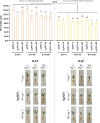Boosting lily bulblets production: a study on the effects of 6-benzylaminopurine and silver nanoparticles
- PMID: 40593166
- PMCID: PMC12216997
- DOI: 10.1038/s41598-025-06078-7
Boosting lily bulblets production: a study on the effects of 6-benzylaminopurine and silver nanoparticles
Abstract
The lily stands out as one of the most economically relevant flowers worldwide and enjoys great popularity as a cut flower in the florist industry. This prominent position underlines the need to implement and continuously improve sustainable protocols that ensure its efficient production, multiplication and conservation. In this context, the present study aimed to investigate the potential biostimulant effect of Silver Nanoparticles (AgNPs) and 6-Benzylaminopurine (BAP) on two lily cultivars (Lilium LA Hybrid 'Hyde Park' and Lilium LA Hybrid 'Yellow Diamond'), through their individual and combined application. The research focused on evaluating the influence of these treatments on two key aspects: (1) regeneration capacity and bulblet development from bulb scales, and (2) morpho-physiological growth parameters in regenerated plants. Analysis of the results revealed several significant effects of the interaction between AgNPs and BAP on different regeneration and growth parameters in two lily cultivars. In cv. 'Hyde Park', the combination of AgNPs at 50 mg L-1 with BAP at 200 mg L-1 increased bulblet number to an average of 5.6. In cv. 'Yellow Diamond', the application of AgNPs at 50 mg L-1 without BAP and the combined treatment of AgNPs at 100 mg L-1 with BAP at 200 mg L-1 produced a higher number of bulblets (3.2). The highest bulblet weight in both cultivars was obtained with the combination of AgNPs at 100 mg L-1 and BAP at 50 mg L-1. Plant height also varied considerably; in cv. 'Hyde Park' the tallest plants (greater than 140 mm) were recorded under treatment with BAP at 50 mg L-1 without AgNPs, while in cv. 'Yellow Diamond', the largest plants (greater than 100 mm) were observed with the application of AgNPs at 100 mg L-1 without BAP. In terms of physiology, the SPAD index did not show significant improvements compared to the control group. In conclusion, the results indicate that the impact of the interaction between AgNPs and BAP is concentration, cultivar, and measured variable dependent, suggesting a varietal-specific response and the possibility of both beneficial and adverse effects on different aspects of lily development. This underscores the importance of carefully adjusting doses and combinations to optimize regeneration and plant growth.
Keywords: Bulb scale; Cytokinin; Growth regulators; Nanotechnology; Propagation.
© 2025. The Author(s).
Conflict of interest statement
Declarations. Competing interests: The authors declare no competing interests.
Figures










Similar articles
-
Optimizing micropropagation and microcorm induction in saffron (Crocus sativus L.) using PGRs (NAA and BAP) and elicitor salicylic acid.BMC Plant Biol. 2025 Jul 4;25(1):877. doi: 10.1186/s12870-025-06900-4. BMC Plant Biol. 2025. PMID: 40615787 Free PMC article.
-
Sertindole for schizophrenia.Cochrane Database Syst Rev. 2005 Jul 20;2005(3):CD001715. doi: 10.1002/14651858.CD001715.pub2. Cochrane Database Syst Rev. 2005. PMID: 16034864 Free PMC article.
-
Green synthesis of silver nanoparticles from plant Astragalus fasciculifolius Bioss and evaluating cytotoxic effects on MCF7 human breast cancer cells.Sci Rep. 2025 Jul 15;15(1):25474. doi: 10.1038/s41598-025-05224-5. Sci Rep. 2025. PMID: 40664749 Free PMC article.
-
Galantamine for Alzheimer's disease.Cochrane Database Syst Rev. 2002;(3):CD001747. doi: 10.1002/14651858.CD001747. Cochrane Database Syst Rev. 2002. Update in: Cochrane Database Syst Rev. 2004 Oct 18;(4):CD001747. doi: 10.1002/14651858.CD001747.pub2. PMID: 12137632 Updated.
-
Levetiracetam add-on for drug-resistant focal epilepsy: an updated Cochrane Review.Cochrane Database Syst Rev. 2012 Sep 12;2012(9):CD001901. doi: 10.1002/14651858.CD001901.pub2. Cochrane Database Syst Rev. 2012. PMID: 22972056 Free PMC article.
References
-
- Royandazagh, S. D. Efficient approaches to in vitro multiplication of Lilium candidum L. with consistent and safe access throughout year and acclimatization of plant under hot-summer mediterranean (Csa type) climate. Not. Bot. Horti Agrobot. Cluj-Napoca47, 734–742 (2019).
-
- Salachna, P., Byczyńska, A., Zawadzińska, A., Piechocki, R. & Mizielińska, M. Stimulatory effect of silver nanoparticles on the growth and flowering of potted oriental lilies. Agronomy9, 610 (2019).
-
- Millones, C. E., Neri, J. C. & Ramos, H. Efecto de reguladores ANA, BAP y KIN en la inducción de bulbillos a partir de escamas de azucena (Lilium sp). INDES Rev. Investig. Para El Desarro. Sustentable1, 16–20 (2013).
-
- Vera, M. Á., Millones, C. E. & Vásquez, E. R. Inducción de bulbillos de azucena (Lilium sp.) a partir de escamas, empleando auxinas y citocininas. Sci. Agropecu.11, 75–81 (2020).
-
- Lapiz-Culqui, Y. K. et al. In Vitro bulbification of five lily varieties: An effective method to produce quality seeds and flowers. Int. J. Agron.2022, e8775989 (2022).
MeSH terms
Substances
LinkOut - more resources
Full Text Sources

